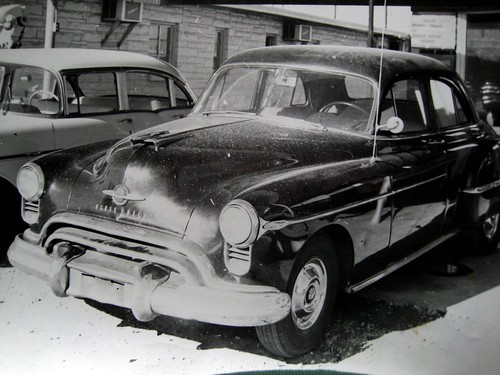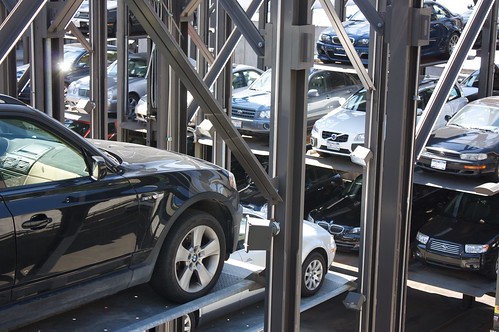 It's almost done; ribbon cutting is scheduled for May 20. Even before I moved to a part of Arlington that is not far from Seven Corners, I was aware of the significant number of pedestrian deaths that were occurring along the stretch of Route 50 (Arlington Boulevard) near Patrick Henry Drive and Seven Corners (right by the Home Depot to point out a familiar landmark).
It's almost done; ribbon cutting is scheduled for May 20. Even before I moved to a part of Arlington that is not far from Seven Corners, I was aware of the significant number of pedestrian deaths that were occurring along the stretch of Route 50 (Arlington Boulevard) near Patrick Henry Drive and Seven Corners (right by the Home Depot to point out a familiar landmark).  It is the deadliest intersection in all of Fairfax County, accounting for approximately 25% of all pedestrian fatalities in the county: on average 2-4 per year. The county has known this is a problem area since at least 1987. I don't have the statistics, but extrapolating from known numbers, more than 50 pedestrians may have been killed here in the last 20 years. Here's a map of the area (one detail: the actual location of the bridge is somewhat west of what is shown. This is taken from the official VDOT site).
It is the deadliest intersection in all of Fairfax County, accounting for approximately 25% of all pedestrian fatalities in the county: on average 2-4 per year. The county has known this is a problem area since at least 1987. I don't have the statistics, but extrapolating from known numbers, more than 50 pedestrians may have been killed here in the last 20 years. Here's a map of the area (one detail: the actual location of the bridge is somewhat west of what is shown. This is taken from the official VDOT site).
Creating separate pedestrian facilities is often not the best solution. What I, and many progressive urban planners believe is better, is to make our streets and roads more accessible, safer and more usable for all users: pedestrians, cyclists, Segway riders, and cars. Sometimes planners will create a poorly designed or planned pedestrian facility that will then "relieve" them of their responsibility to think more holistically about the interactions of road users. I agree with this viewpoint, but in this case, the pedestrian bridge at Seven Corners is a big, big improvement, and probably is the only reasonably safe enhancement that can be implemented in the short term. It also is located where pedestrians have generally wanted to cross and where many have been injured or killed.
Prior to the construction of this bridge, the only possible crossing points were at Patrick Henry Drive (not all that safe either: pedestrians have been killed in the crosswalk; the county has improved this crossing in the last couple years, but it's still a 6-lane highway) and Cherry Street, a distance of 1.3 miles from each other. Although one could cross at the Seven Corners overpasses, it requires a brave and fleet person to do so. There are no actual pedestrian facilities like sidewalks or lights there. So crossing at either Patrick Henry or Cherry St. requires a very long schlep, thus many people choose to make the mad dash across Route 50. For years the county tried to force pedestrians to the crossing at Patrick Henry rather than find a safe solution to their need to cross closer to their destinations.
There are homes, apartments and significant commerce on both sides of the highway, so there are lots of reasons for people to cross. One would think that the businesses would have an interest in making it easier for people to reach their establishments, too. I do not know if they were engaged in the project, though. On more than one occasion I have been in the Sunflower Restaurant looking out at the Guitar Center, seemingly close enough to touch--or at least hit with a golf ball. I measured with Google, and it's about 200 yards, so a golfer could conceivably hit one onto the Guitar Center roof from the restaurant. However, if I wanted to walk there, I could not do it. Impossible. Perhaps one could walk down Route 7 to Patrick Henry, cross there and go back up, a distance of 1.2 miles. I'm not sure there are sidewalks along this entire route, though.
By the new bridge, this distance is now still about 1/2 mile, but considerably more direct, doable and obvious to potential pedestrians.
So all in all, I believe this is a significant improvement. However, the county needs to continue to improve this area as well as the entire length of Route 50 inside the Beltway, where usable pedestrian crossings are few and far between. Here are my thoughts about this project:
- Way, way overdue, as mentioned above.
- It took a long time. This project was started in the fall of 2007. Originally it was supposed to be complete last November. Unfortunately, the original truss that was delivered was cracked, which caused a several-months delay.
- Why does the north side empty out inside the frontage road, so people still have to cross another lane of traffic to get to the sidewalk (see photos)? If the frontage road had been shifted a little southward, the bridge would need to be somewhat longer, but not much. They completely rebuilt this entire area, so it could have been designed that way. I often wonder why--when we're building a piece of infrastructure that will be there for 40 years or more--that more thought isn't put into these details.
- Pedestrian access on both sides needs to be addressed now that the bridge is complete. Completing well designed sidewalks and creating pedestrian access to cross the parking lots will make the bridge much more usable.
- There are still way too few ways to cross in this 1.3 mile stretch. Seven Corners itself needs to be rethought and redesigned to accommodate other road users besides cars (and it doesn't even do a very good job with those!) [Update: I learned at the ribbon cutting that this will happen in a couple of years.]
- It probably cost too much (I've read $2.6 million) [Update: I learned at the ribbon cutting that total costs were more like $8 million!]. Although it appears to be an excellent facility, Fairfax County is not known for its willingness to invest in bike/ped facilities. I suspect that the next time someone suggests an improvement, the county will say, "But that one at Seven Corners cost so much; we can't afford to spend that kind of money willy nilly on pedestrians."
I've also included a number of photos below, which you can expand by clicking. There's also a great article in the Falls Church News Press by Penny Gross describing the placement of the main bridge section a couple of weeks ago.
 Taken in February from the Barnes & Noble parking lot prior to installation of the bridge (click to enlarge)
Taken in February from the Barnes & Noble parking lot prior to installation of the bridge (click to enlarge)
 Looking east from Seven Corners. Home Depot is behind the bridge to the right (click to enlarge).
Looking east from Seven Corners. Home Depot is behind the bridge to the right (click to enlarge).
 Looking West along Route 50. You can see the ramp pedestrians will come down and then have to cross the frontage road on the right to get to the sidewalk. Dumb. (Click to enlarge)
Looking West along Route 50. You can see the ramp pedestrians will come down and then have to cross the frontage road on the right to get to the sidewalk. Dumb. (Click to enlarge)

At the top of the ramp looking south across the bridge. Still a little work being finished up.
==========
(Cross posted with lots of comments on GreaterGreaterWashington)

 If you are worried only about your own personal environmental footprint, then I think the used car is likely better. But if you are concerned about the entire planet (which if you are asking environmental questions like this, you presumably are), then a larger circle has to be drawn than just around yourself, and that changes the answer.
If you are worried only about your own personal environmental footprint, then I think the used car is likely better. But if you are concerned about the entire planet (which if you are asking environmental questions like this, you presumably are), then a larger circle has to be drawn than just around yourself, and that changes the answer. In fact, every car that is manufactured will be on the road until it finally is totaled or gives up the ghost. Your particular ownership of that car is just a way station on the path from manufacturer to junkyard.
In fact, every car that is manufactured will be on the road until it finally is totaled or gives up the ghost. Your particular ownership of that car is just a way station on the path from manufacturer to junkyard.






